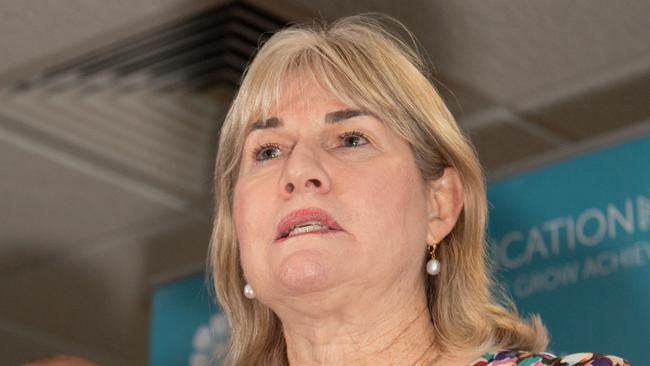NT schools in crisis: Bureaucrats ‘keep schools running’
Remote schools in the Northern Territory ‘provide better than … what we see in other states’, NT Education Minister Eva Lawler has claimed.

Remote schools in the Northern Territory “provide better than … what we see in other states”, NT Education Minister Eva Lawler has claimed, despite an annual funding shortfall of $214.8m for Territory schools.
Ms Lawler also said the high number of education bureaucrats in the NT was needed to “keep schools running”.
The Australian’s NT Schools in Crisis series has revealed a shortfall of $214.8m a year for Territory schools, which disproportionately affects the country’s most disadvantaged students under the attendance-based funding model that operates nowhere else in the country.
Among the worst affected are Homeland Learning Centres – outer hubs of bigger schools – catering for about 400 children, which often have only part-time teachers and classrooms with no power or water.
“If you had eight students from one family, in a little town in outback Queensland, outback Western Australia, their parents would be either having to move, send them to boarding school or drive them to get an education, it’s no different in the Northern Territory,” Ms Lawler said.
“Actually it is different because we provide better than … what we see in other states. We provide education on country in those homelands, but it is really hard to deliver that when you have highly mobile students, highly mobile families, small populations there. I think we do a strong job, a good job with the resources that we have.”
When asked if she was suggesting Indigenous people should move from their traditional homelands into larger communities, Ms Lawler said: “If that’s what parents have to do in other places in other states of Australia where – yes we know it’s valuable for families, we know the benefits of living in a homeland, but we also understand how difficult that is to provide education.”
The Australian revealed HLCs often had a registered teacher visiting only once or twice a week, with a local assistant teacher left to deliver classes alone the rest of the time.
Some HLCs have gone months without a teacher visit.
The Weekend Australian reported on several remote homeland communities that have turned their backs on the NT government and created their own independent schools, with full-time teachers and attendance up to 89 per cent when students are in the community.
Federal Education Minister Jason Clare said Territory students were the most underfunded in the country, receiving only 80 per cent of the minimum standard recommended under the Gonski reforms.
Ms Lawler said she was “fighting hard” with the federal government to get to full funding for NT students.
“We have the highest funding, about $28,000 per student in Australia around funding for our students in the Northern Territory. Do we want more funding? Absolutely we want more funding.”
However, because of the attendance-based funding model in the Territory, the allocation of funds meant schools in remote communities were the likeliest to miss out.
The ABC reported on Monday that documents gained under Freedom of Information legislation showed that schools in remote NT communities were missing out on as much as $3.4m a year because of attendance-based enrolment, which Ms Lawler said would remain in place until 2025.
The figures appeared in a draft review of attendance-based funding but were removed from the final report that was released last year.
Ms Lawler denied the funding model had anything to do with keeping money in Darwin schools, which held more power in securing votes at the upcoming election.
“It’s not about taking money from urban to remote, it’s the same for all of them,” she said. “The issue is that the students in remote aren’t always going to school.”
She claimed there was an “absolutely incorrect lack of understanding” when it came to the number of bureaucrats in the NT Education Department, which sucked up more than half of the Territory’s $1.179bn education budget.
Productivity Commission data shows 704 staff “not-active” in NT public schools and Australian Education Union NT analysis reveals that for every 1000 students, the NT has 24 non-school staff, compared with nine in the ACT and eight in Tasmania.
“We might have more per student, but the issue is we need that support centrally,” Ms Lawler said. “We have a very different education system to every other state. People who’ve been in the system understand that need to have more people in that corporate area – there’s probably a lot less than there’s been in the past.”



To join the conversation, please log in. Don't have an account? Register
Join the conversation, you are commenting as Logout